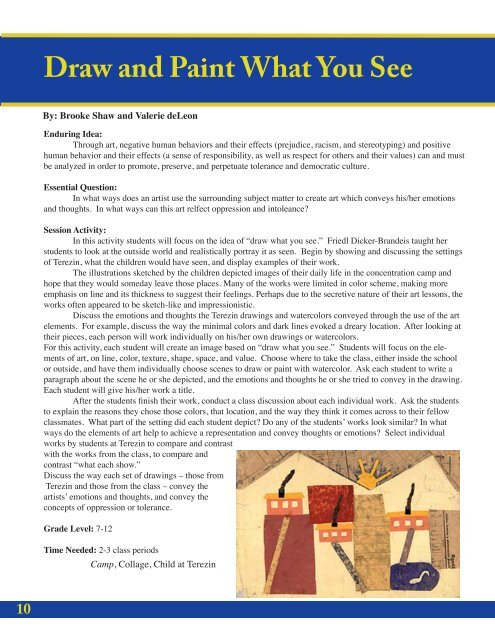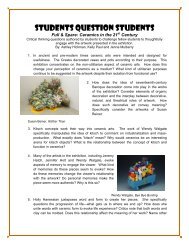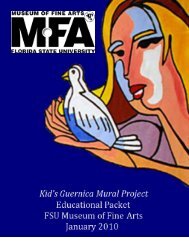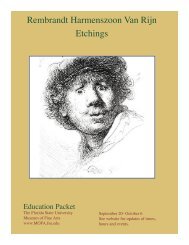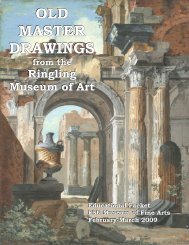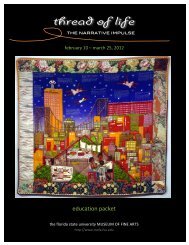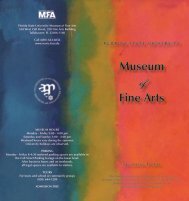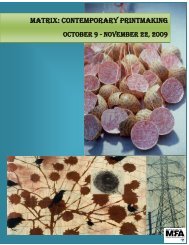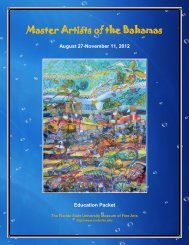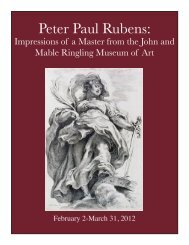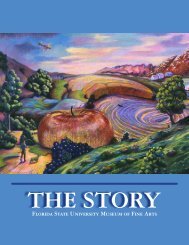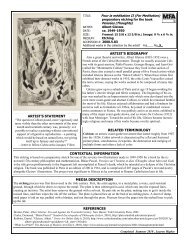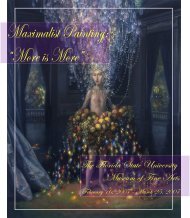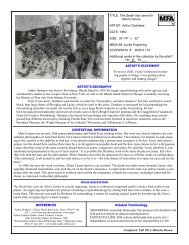Friedl Dicker-Brandeis and Ela Weissberger at Terezin
Friedl Dicker-Brandeis and Ela Weissberger at Terezin
Friedl Dicker-Brandeis and Ela Weissberger at Terezin
- No tags were found...
You also want an ePaper? Increase the reach of your titles
YUMPU automatically turns print PDFs into web optimized ePapers that Google loves.
Draw <strong>and</strong> Paint Wh<strong>at</strong> You SeeBy: Brooke Shaw <strong>and</strong> Valerie deLeonEnduring Idea:Through art, neg<strong>at</strong>ive human behaviors <strong>and</strong> their effects (prejudice, racism, <strong>and</strong> stereotyping) <strong>and</strong> positivehuman behavior <strong>and</strong> their effects (a sense of responsibility, as well as respect for others <strong>and</strong> their values) can <strong>and</strong> mustbe analyzed in order to promote, preserve, <strong>and</strong> perpetu<strong>at</strong>e tolerance <strong>and</strong> democr<strong>at</strong>ic culture.Essential Question:In wh<strong>at</strong> ways does an artist use the surrounding subject m<strong>at</strong>ter to cre<strong>at</strong>e art which conveys his/her emotions<strong>and</strong> thoughts. In wh<strong>at</strong> ways can this art relfect oppression <strong>and</strong> intoleance?Session Activity:In this activity students will focus on the idea of “draw wh<strong>at</strong> you see.” <strong>Friedl</strong> <strong>Dicker</strong>-<strong>Br<strong>and</strong>eis</strong> taught herstudents to look <strong>at</strong> the outside world <strong>and</strong> realistically portray it as seen. Begin by showing <strong>and</strong> discussing the settingsof <strong>Terezin</strong>, wh<strong>at</strong> the children would have seen, <strong>and</strong> display examples of their work.The illustr<strong>at</strong>ions sketched by the children depicted images of their daily life in the concentr<strong>at</strong>ion camp <strong>and</strong>hope th<strong>at</strong> they would someday leave those places. Many of the works were limited in color scheme, making moreemphasis on line <strong>and</strong> its thickness to suggest their feelings. Perhaps due to the secretive n<strong>at</strong>ure of their art lessons, theworks often appeared to be sketch-like <strong>and</strong> impressionistic.Discuss the emotions <strong>and</strong> thoughts the <strong>Terezin</strong> drawings <strong>and</strong> w<strong>at</strong>ercolors conveyed through the use of the artelements. For example, discuss the way the minimal colors <strong>and</strong> dark lines evoked a dreary loc<strong>at</strong>ion. After looking <strong>at</strong>their pieces, each person will work individually on his/her own drawings or w<strong>at</strong>ercolors.For this activity, each student will cre<strong>at</strong>e an image based on “draw wh<strong>at</strong> you see.” Students will focus on the elementsof art, on line, color, texture, shape, space, <strong>and</strong> value. Choose where to take the class, either inside the schoolor outside, <strong>and</strong> have them individually choose scenes to draw or paint with w<strong>at</strong>ercolor. Ask each student to write aparagraph about the scene he or she depicted, <strong>and</strong> the emotions <strong>and</strong> thoughts he or she tried to convey in the drawing.Each student will give his/her work a title.After the students finish their work, conduct a class discussion about each individual work. Ask the studentsto explain the reasons they chose those colors, th<strong>at</strong> loc<strong>at</strong>ion, <strong>and</strong> the way they think it comes across to their fellowclassm<strong>at</strong>es. Wh<strong>at</strong> part of the setting did each student depict? Do any of the students’ works look similar? In wh<strong>at</strong>ways do the elements of art help to achieve a represent<strong>at</strong>ion <strong>and</strong> convey thoughts or emotions? Select individualworks by students <strong>at</strong> <strong>Terezin</strong> to compare <strong>and</strong> contrastwith the works from the class, to compare <strong>and</strong>contrast “wh<strong>at</strong> each show.”Discuss the way each set of drawings – those from<strong>Terezin</strong> <strong>and</strong> those from the class – convey theartists’ emotions <strong>and</strong> thoughts, <strong>and</strong> convey theconcepts of oppression or tolerance.Grade Level: 7-12Time Needed: 2-3 class periodsCamp, Collage, Child <strong>at</strong> <strong>Terezin</strong>10


